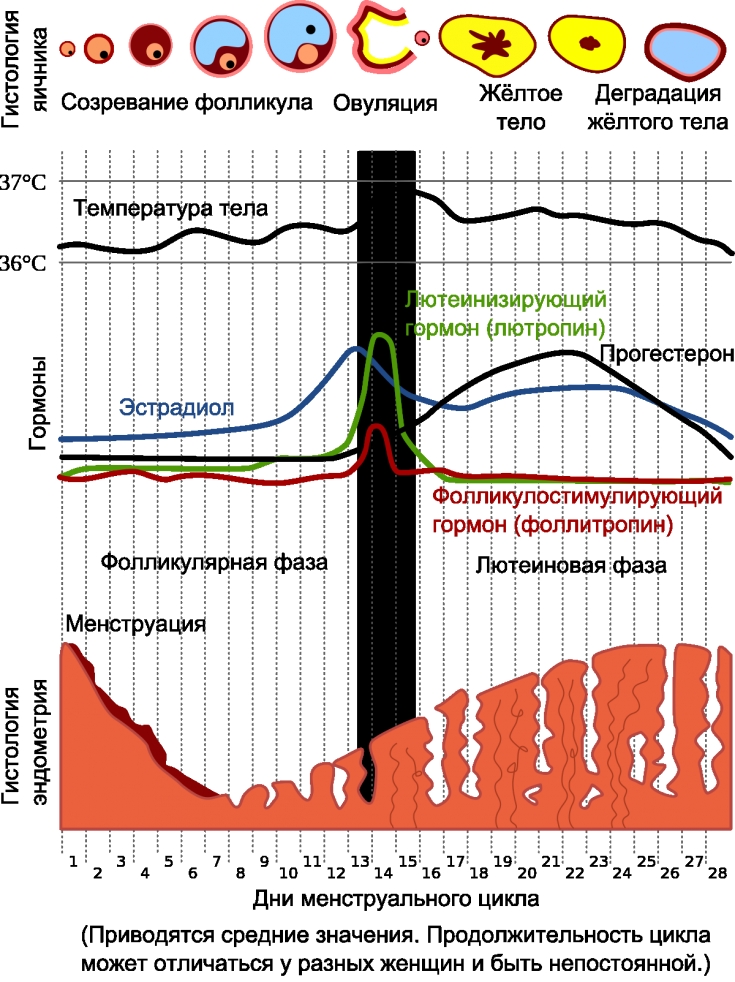In most cases, a woman's hormonal cycle is 28 days, during which time the body prepares for pregnancy by increasing the level of progesterone in the body.
If conception does not occur, then the level of the pregnancy hormone drops sharply and the concentration of prostaglandins in the blood increases, which cause spasm of blood vessels. During this period, the woman has a decrease in the emotional background and a sharp change in mood.
estet-portal.com will tell you what advice you can
1. Hormonal cycle: phase of menstruation (monthly)
2. Preparatory phase of the hormonal cycle before ovulation
3. Ovulation as the central event of the hormonal cycle
4. Hormonal Cycle: Post-Ovulation and Premenstrual Syndrome
Hormonal cycle: menstrual phase (menses)
The first day of the menstrual cycle is considered to be the first day of menstruation. The duration of this phase is from 3 to 6-7 days.
These days a woman may feel
characteristic of menstruation, pulling pains in the lower abdomen, more in the first days. Due to the fact that
the level of pregnancy hormones drops sharply, the lining of the uterus, which was previously prepared for pregnancy, is shed. Hormonal changes are associated with
both mental lability and mood swings. These days, households should be more patient with a woman.
Follow us onInstagram. The preparatory phase of the hormonal cycle before ovulation
After the cessation of menstrual flow, the female body begins to prepare for pregnancy again. At the head of this process is the pituitary gland, which begins to produce
follicle stimulating hormone (FSH). It has a direct effect on the ovaries and promotes the maturation of the egg. The egg contains a large number of follicles with immature eggs. FSH promotes the growth and maturation of the follicle. Every day
the level of estrogenin the blood increases, contributing to the saturation of the uterine mucosa with nutrients. If implantation of a fertilized egg occurs, it will feed on this mucosa. Estrogens influence the production of cervical mucus, which helps to transport
sperms to their destination and keep them viable for several days. Ovulation as the central event of the hormonal cycle
At this time, estrogen continues to rise in the blood, which at some point causes an ovulatory surge of luteinizing hormone (a sharp increase in LH levels). As a rule, at the 28th cycle, this happens on the 14th day.
The surge leads to the rupture of the mature dominant follicle, the release of the egg and its entry into the fallopian tube. This
phase is ovulation and for many people it is accompanied by pain in the side of the pelvis where the ruptured follicle is located. They can last even days. During the period of ovulation, the risk of pregnancy is very high.
The egg is released from the ruptured follicle and moves into the uterine cavity through the fallopian tube. It remains viable for 24 hours, and spermatozoa live up to 5 days.
Therefore, the chance of getting pregnant is highest the last few days before ovulation and the day of ovulation itself.
After ovulation, the production of the second hormone – progesterone, which prepares the body for pregnancy.
The ruptured follicle shrinks, and progesterone production also decreases, but at the same time it begins to produce estrogen.
This
hormonal backgroundcontributes to symptoms such as irritability, depression, frequent mood swings, drowsiness, swelling, engorgement and soreness of the mammary glands. The complex of these symptoms is commonly called premenstrual syndrome (PMS). When the egg dies, the uterus no longer needs to maintain the environment needed for conception. Therefore, the uterus needs to cleanse itself and prepare for the next hormonal cycle.
If fertilization occurs, then the body begins to produce pregnancy hormone – chorionic gonadotropin, which prevents rejection of the uterine mucosa.
Thus, thehormonal cycle
we have considered is divided into several phases, which differ not only in a certain set of hormones, but also in the woman's well-being. It lasts for 28 days. Small deviations of a couple of days are possible and acceptable. If the deviation is greater, you should
talk about it with your gynecologist. Mood swings in a woman, the presence of depression and sexual behavior are necessarily associated with the stages of the premenstrual and menstrual periods: for some it is more pronounced, for some it is less.
Hormonal balance: the lives of women 35+
You may be interested in: Memory Test.









Add a comment